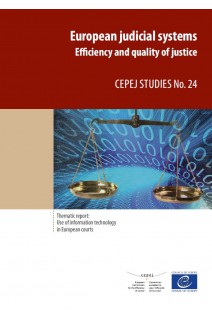



The Council of Europe’s European Commission for the Efficiency of Justice (CEPEJ) carried out a thorough evaluation of the use of information technology (IT) in the judicial systems of the Organisation’s Member states as part of the CEPEJ’s 2014-2016 cycle. The aim was not only to draw up an inventory of the development of information technology tools and applications in the courts and prosecution services but also to identify very first means of analysis of their impact on the efficiency and quality of the public service of justice. The first part of the report is devoted to a thorough analysis of the State of development of IT. This analysis leads to a confirmation of the trend outlined in previous reports: most countries have invested significantly in IT for the functioning of their courts. This preliminary finding makes it possible identifying in a second part of this report other trends regarding the impact of information technology from the perspective of efficiency and quality.
OVERVIEW OF THE REPORT
INTRODUCTION
PART ONE: STATE OF IT DEVELOPMENT IN JUDICIAL SYSTEMS
1.1 SUMMARY OF THE METHODOLOGY USED TO CALCULATE DEVELOPMENT INDICES
1.2 SUMMARY OF DEVELOPMENT INDICES
1.2.1 IT equipment
1.2.2 Organisation and governance of information s ys tems
1.2.3 Legislative framework
PART TWO: THE INFLUENCE OF THE USE OF INFORMATION TECHNOLOGIES IN THE JUDICIAL SYSTEMS
2.1 THE CREATION OF A GLOBAL IT DEVELOPMENT INDEX
2.1.1 The method
2.1.2 The results
2.2 A TWOFOLD PERSPECTIVE: EFFICIENCY AND QUALITY OF THE JUDICIAL SYSTEM
2.2.1 The criteria of “efficiency” and “quality”
2.2.2 Introduction of information technologies: evaluation of their specific contribution in terms of the e fficiency and quality of judicial sys tems
2.2.3 Applying general indicators of efficiency to information technologies: putting their impact on the efficiency and quality of judicial systems into perspective
2.3 SUMMARY OF THE FINDINGS
INDEX
ANNEX 1: TABLES WITH THE ANSWERS OF THE STATES OR ENTITIES (Q62 TO Q65, Q66 TO Q83.3)
ANNEX 2: COUNTRY FICHES
ANNEX 3: FRAMEWORK USED FOR THE EVALUATION
ANNEX 4: FRAMEWORK USED TO SET THE GLOBAL IT DEVELOPMENT LEVEL
ANNEX 5: KEY OF ABBREVIATIONS USED TO IDENTIFY COUNTRIES
ANNEX 6: QUESTIONNAIRE
ANNEX 7: EXPLANATORY NOTE
ANNEX 8: DEFINITION OF THE CLEARANCE RATE
ANNEX 9: DEFINITION OF THE DISPOSITION TIME

The Council of Europe’s European Commission for the Efficiency of Justice (CEPEJ) carried out a thorough evaluation of the use of information technology (IT) in the judicial systems of the Organisation’s Member states as part of the CEPEJ’s 2014-2016 cycle. The aim was not only to draw up an inventory of the development of information technology tools and applications in the courts and prosecution services but also to identify very first means of analysis of their impact on the efficiency and quality of the public service of justice. The first part of the report is devoted to a thorough analysis of the State of development of IT. This analysis leads to a confirmation of the trend outlined in previous reports: most countries have invested significantly in IT for the functioning of their courts. This preliminary finding makes it possible identifying in a second part of this report other trends regarding the impact of information technology from the perspective of efficiency and quality.
Attention, en vertu de nos conditions générales de vente, l'achat des PDF/epub est réservé aux particuliers.
